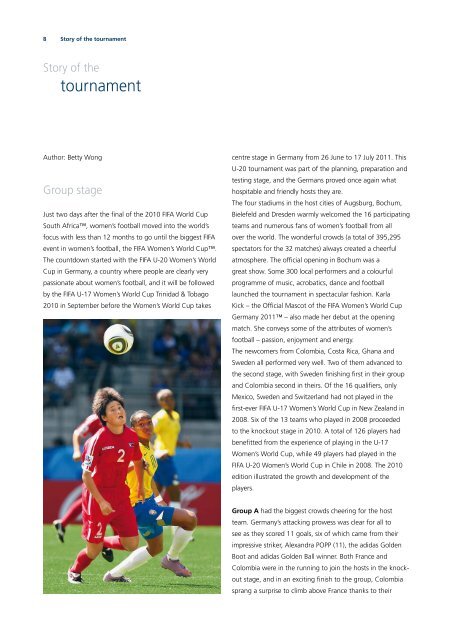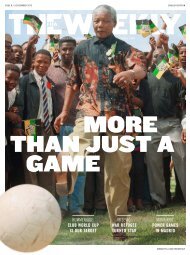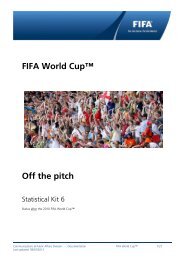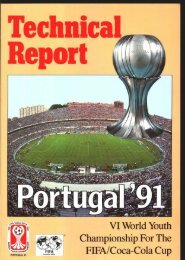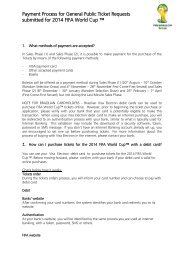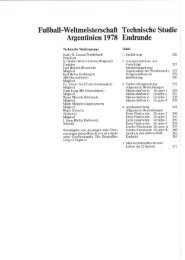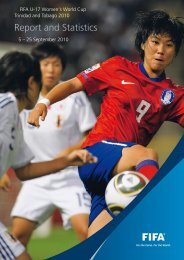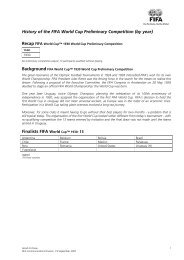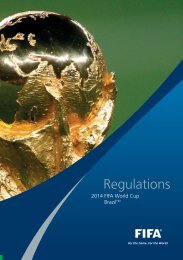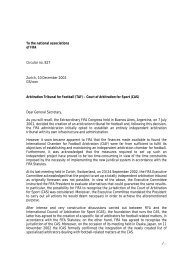Germany 2010 - FIFA.com
Germany 2010 - FIFA.com
Germany 2010 - FIFA.com
- TAGS
- germany
- www.fifa.com
You also want an ePaper? Increase the reach of your titles
YUMPU automatically turns print PDFs into web optimized ePapers that Google loves.
8 Story of the tournament<br />
Story of the<br />
tournament<br />
Author: Betty Wong<br />
Group stage<br />
Just two days after the fi nal of the <strong>2010</strong> <strong>FIFA</strong> World Cup<br />
South Africa, women’s football moved into the world’s<br />
focus with less than 12 months to go until the biggest <strong>FIFA</strong><br />
event in women’s football, the <strong>FIFA</strong> Women’s World Cup.<br />
The countdown started with the <strong>FIFA</strong> U-20 Women’s World<br />
Cup in <strong>Germany</strong>, a country where people are clearly very<br />
passionate about women’s football, and it will be followed<br />
by the <strong>FIFA</strong> U-17 Women’s World Cup Trinidad & Tobago<br />
<strong>2010</strong> in September before the Women’s World Cup takes<br />
centre stage in <strong>Germany</strong> from 26 June to 17 July 2011. This<br />
U-20 tournament was part of the planning, preparation and<br />
testing stage, and the Germans proved once again what<br />
hospitable and friendly hosts they are.<br />
The four stadiums in the host cities of Augsburg, Bochum,<br />
Bielefeld and Dresden warmly wel<strong>com</strong>ed the 16 participating<br />
teams and numerous fans of women’s football from all<br />
over the world. The wonderful crowds (a total of 395,295<br />
spectators for the 32 matches) always created a cheerful<br />
atmosphere. The offi cial opening in Bochum was a<br />
great show. Some 300 local performers and a colourful<br />
programme of music, acrobatics, dance and football<br />
launched the tournament in spectacular fashion. Karla<br />
Kick – the Offi cial Mascot of the <strong>FIFA</strong> Women’s World Cup<br />
<strong>Germany</strong> 2011 – also made her debut at the opening<br />
match. She conveys some of the attributes of women’s<br />
football – passion, enjoyment and energy.<br />
The new<strong>com</strong>ers from Colombia, Costa Rica, Ghana and<br />
Sweden all performed very well. Two of them advanced to<br />
the second stage, with Sweden fi nishing fi rst in their group<br />
and Colombia second in theirs. Of the 16 qualifi ers, only<br />
Mexico, Sweden and Switzerland had not played in the<br />
fi rst-ever <strong>FIFA</strong> U-17 Women’s Wor ld Cup in New Zealand in<br />
2008. Six of the 13 teams who played in 2008 proceeded<br />
to the knockout stage in <strong>2010</strong>. A total of 126 players had<br />
benefi tted from the experience of playing in the U-17<br />
Women’s World Cup, while 49 players had played in the<br />
<strong>FIFA</strong> U-20 Women’s World Cup in Chile in 2008. The <strong>2010</strong><br />
edition illustrated the growth and development of the<br />
players.<br />
Group A had the biggest crowds cheering for the host<br />
team. <strong>Germany</strong>’s attacking prowess was clear for all to<br />
see as they scored 11 goals, six of which came from their<br />
impressive striker, Alexandra POPP (11), the adidas Golden<br />
Boot and adidas Golden Ball winner. Both France and<br />
Colombia were in the running to join the hosts in the knockout<br />
stage, and in an exciting fi nish to the group, Colombia<br />
sprang a surprise to climb above France thanks to their


